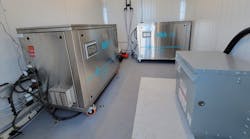Today’s critical global needs for drinkable water include agricultural demands for clean, pure irrigation and a need for drinking water for animals. Terrible devastation around the globe also comes from earthquakes, tsunamis, hurricanes and nuclear disasters, and the water industry must think about these emergency scenarios.
Water can become dangerously contaminated quickly and can cause illness, pain, suffering and panic. Anything that can cause a blackout, flooding or damage to infrastructure could affect water supplies.
The water treatment industry, and especially local water treatment professionals, should be well-educated on how to treat water during an emergency and should take a leadership role in preparing for a disaster. Everything people hear about water treatment is based on the assumption they are starting with safe, potable water. But water treatment during an emergency situation is not the same as standard day-to-day water treatment.
The following information from the Federal Emergency Management Agency (FEMA) and the American Red Cross should be conveyed to the public as simply as possible:
- During an emergency situation, water coming from the tap can become dangerously contaminated without your knowledge, or it may stop flowing completely. You may not know whether your water is contaminated, so it’s important to take precautions.
- Having a supply of safe and clean drinking water is vital to your family’s safety. It is more important than food.
- Five primary categories of contaminants can be in water: particulates, biological, inorganic, radioactive and organic. Biological contaminants, which include bacteria, parasites and viruses, are usually much more dangerous than the other types of contaminants. Biological contaminants can cause illness or death within hours or days.
- While most people have experienced a stomach bug, these routine illnesses are usually just inconveniences. Drinking plenty of water and getting plenty of sleep helps people get better. But when people are unable to drink plenty of water, such an illness can quickly become dangerous and incapacitating.
- FEMA and the Red Cross recommend boiling, chlorination and distillation as the core methods for treating water during an emergency because of the concern over biological contaminants.
- This emphasis on biological contaminants is the reason filters are not recommended as a core method for treating water during an emergency. Filters provide variable protection and should be used only on potable water. Filters, including reverse osmosis filters, can become breeding grounds for bacteria. When filters fail, contaminants can pass through to the filtered water without your knowledge.
- Boiling water is an excellent method for killing biological contaminants in water, but it does not remove biological contaminants or endotoxins created when biological contaminants die. Boiling can actually concentrate other contaminants such as heavy metals. Chlorination also kills biological contaminants in water but does nothing to remove dead biological contaminants or other contaminants.
- Distillation is the only process recommended that kills and removes biological contaminants while also protecting against a broad spectrum of other contaminants. Distillation provides high-purity drinking water for as long as it is needed and can be a permanent method for desalinating ocean water. Distillation requires fuel, such as propane or a wood fire.
In Oregon, a commission recently issued a report indicating that studies have shown that the coast of Oregon is overdue for a major earthquake. Learning lessons from Japan, recognizing the benefits of advanced planning and noting that Oregonians were less prepared than the Japanese, the state has urged citizens to have disaster plans in place. This is a good example of education happening before an emergency happens. Afterwards will always be too late.


